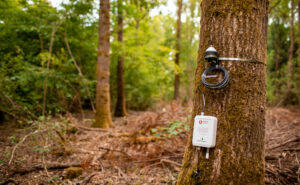Summary
An ongoing project between Forest Research, Defra and Vodafone is exploring how the Internet of Things (IoT) can be used in environmental and forest monitoring at remote forest sites. A pilot study is currently underway where a new generation of IoT sensors and communication devices is being used to monitor tree growth and a range of associated environmental variables.
Research Objectives
International attempts to limit greenhouse gas (GHG) concentrations, aimed at stabilizing human induced climate change, require a detailed understanding of the current and potential future role of forests to sequester carbon. Accurate, high frequency and reliable measurements are vital in developing effective mitigation strategies and help to improve understanding of the other ecosystem services provided by forests.
However, forests are typically located in remote, rural environments which can make regular access for surveyors and other forest scientists challenging and logistically difficult. Forest Research is working with partners to explore how IoT technology can be used to improve environmental and forest monitoring and to test its suitability at remote rural locations in the UK.
Latest Update
A pilot study is currently underway at Forest Research’s two long-term carbon flux sites, Alice Holt (Hampshire) and Harwood (Northumberland) using IoT technology to measure and transmit high frequency growth and environmental data. Tree growth sensors (automated dendrometers) and a range of other sensors, attached to the trees and in the soil, are connected to the Vodafone Narrowband-IoT (NB-IoT) network. Data are uploaded every 15 minutes to an online web portal, providing researchers with near real time access to the data Overall this trial has been very successful. At the Alice Holt site data capture has been high (>95%) with the sensors providing good quality data. Although data capture has not been as high at the Harwood site, valuable lessons are being learned, especially about NB-IoT network penetration in dense conifer stands which will help to inform future research. Overall, this ongoing project is demonstrating that this new technology has the potential to deliver continuous, high-quality data from forest sites.

